Discover 15 hidden attractions, cool sights, and unusual things to do in Brașov (Romania). Don't miss out on these must-see attractions: Tâmpa, Biserica Neagră, and Sinagoga Beth Israel. Also, be sure to include Brașov County Museum of History in your itinerary.
Below, you can find the list of the most amazing places you should visit in Brașov (Brașov).
Table of Contents
Tâmpa
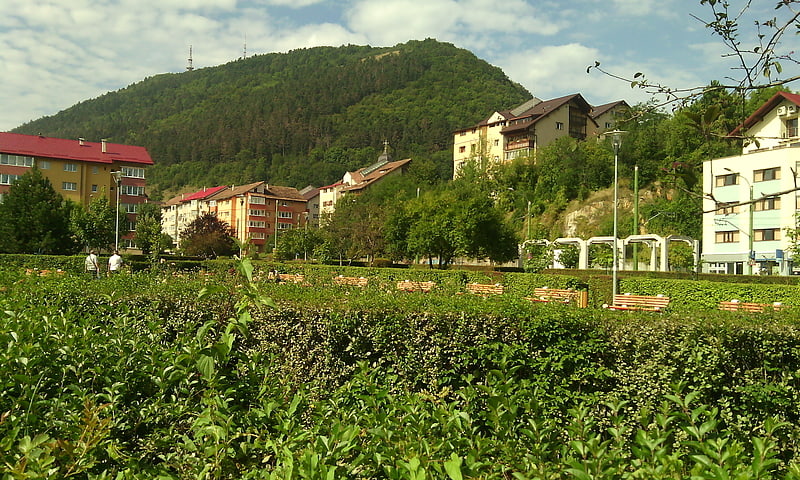
Scenic mountain with trails and city views. Tâmpa is a mountain, part of the Postăvarul Massif, located in the southern part of the Eastern Carpathians and almost entirely surrounded by the city of Brașov. Its elevation is 960 m, almost 400 m above the city.
The mountain is mostly made up of limestone formations, having risen up gradually from the Earth's crust.
Most of the mountain (1.5 km²) is a declared nature reserve, due to the rare animal species (bears, birds, butterflies—35% of Romanian butterfly species) and plant species (a rare Liverleaf variety, Transylvanian Windgrass) that are found there. A number of routes to the summit exist: there are 25 winding paths cut in 1837 by Brașov's forest administration; Gabony's stairs; the Knights' road, dating to the days of the Brașovia citadel; and an auto road. A cable car makes the journey between the cabin/restaurant Casa Pădurarului at the base of the mountain to the Restaurantul Panoramic, on its crest, in under three minutes. The view from the summit is spectacular, offering a panoramic view of the city; on a clear day, the entire Burzenland is visible.[1]
Biserica Neagră
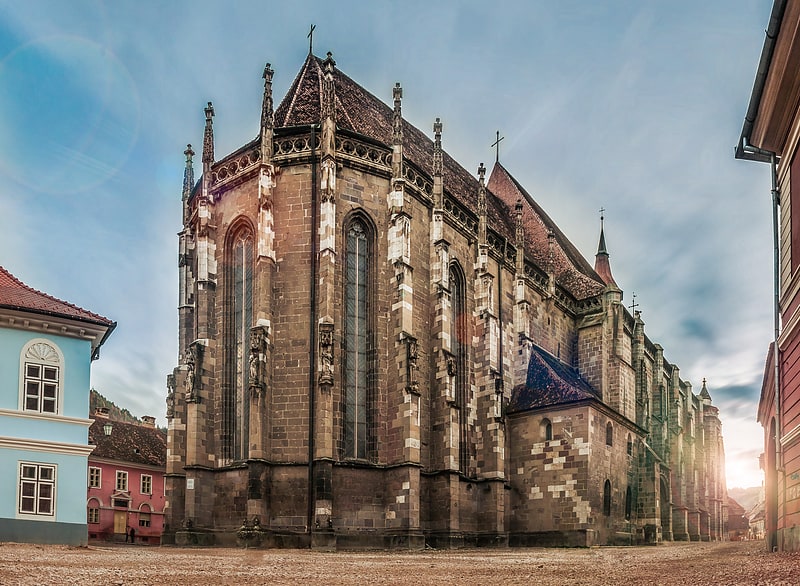
Massive church named for long-ago fire. The Black Church, Biserica Neagră in Romanian, stands in the city of Brașov in south-eastern Transylvania, Romania. It was built by the Saxon community of the city and represents the main Gothic-style monument in the country, as well as being the largest and one of the most important houses of worship in the region which belong to the Lutheran, i.e. Evangelical Church of Augustan Confession in Romania.
Author Judit Petki contends that, contrary to a widely held view, the Black Church did not receive its dark appearance as a result of the fire which affected much of the city in 1689, but only in recent times due to pollution. The current popular name is apparently a 19th-century creation.
The cathedral, a working church, is the main city landmark of historical Brașov, and a museum is open to visitors.[2]
Address: Curtea Johannes Honterus 2, 500025 Brașov
Sinagoga Beth Israel
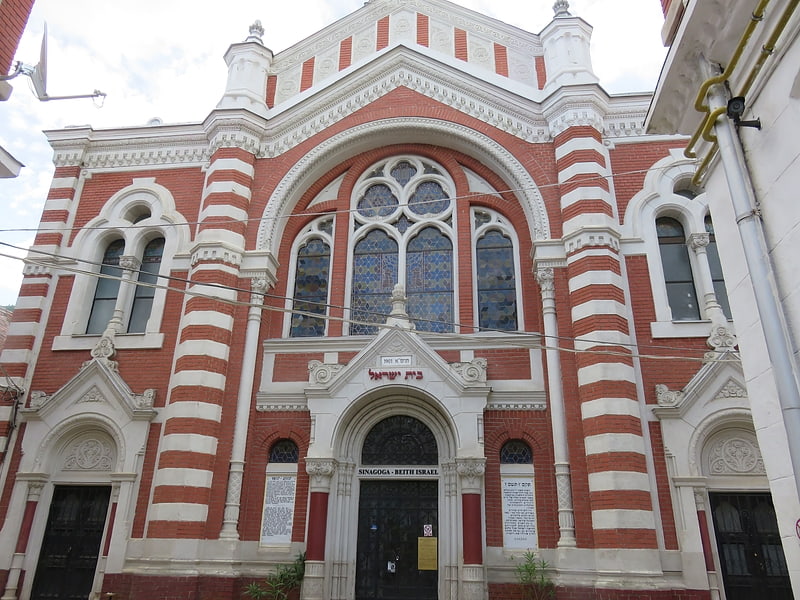
The Beth Israel Synagogue in Brasov, a neological synagogue in the vernacular language, stands at 29 Poarta Șchei Street in the center of Brasov, Romania, behind the street front, on a plot surrounded by houses. The synagogue still plays a ritual role. The building complex includes a community seat and a kosher restaurant. Beth Israel Synagogue is included in the list of National Historic monuments in Romania under the number BV-II-m-B-11515.[3]
Brașov County Museum of History
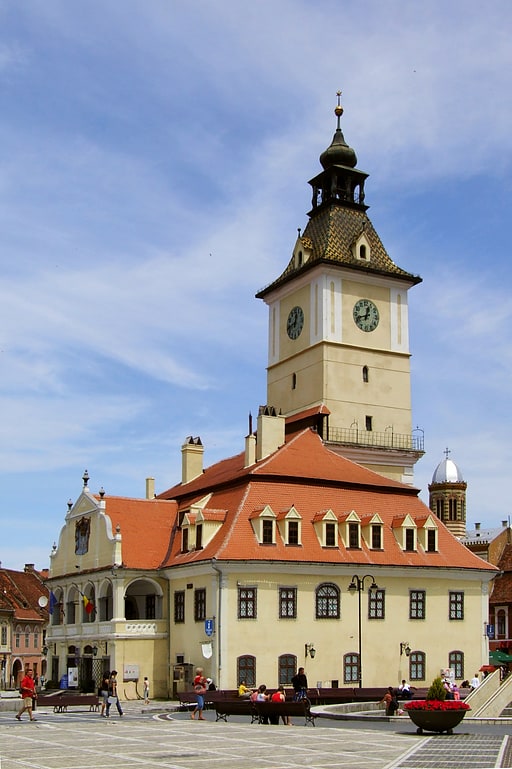
Also known as: Muzeul Județean de Istorie din Brașov
Museum in Brașov, Romania. The Brașov County Museum of History is a history museum in Brașov, Romania.
The museum, founded in 1950, is housed in the former Council House at the centre of Piața Sfatului, the main historic square of the city.[4]
Address: Piața Sfatului, Brașov
Catherine's Gate
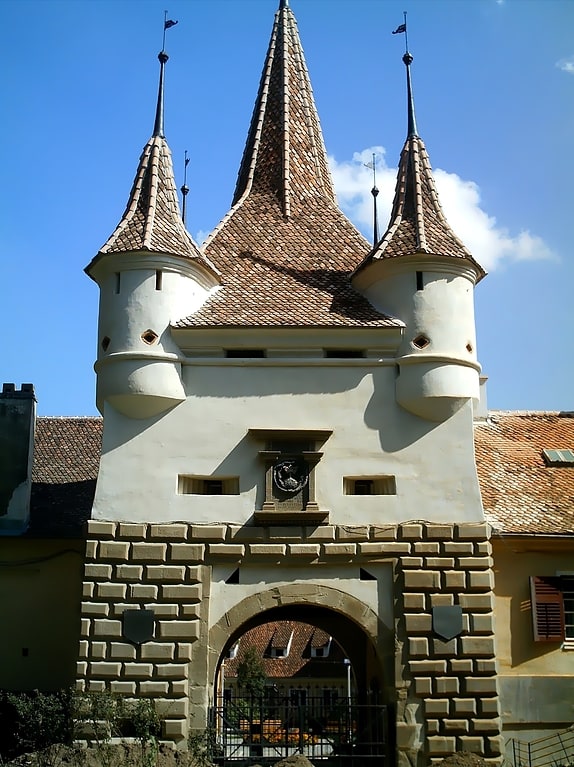
Also known as: Poarta Ecaterinei din Brașov
Museum in a 16th-century stone gate. Catherine's Gate in Brașov, Romania, was built by the Tailors’ Guild, in 1559 for defensive purposes instead of an old gate destroyed by a flood in 1526. It is named after St. Catherine's Monastery that was situated here in former times. It is the only original city gate to have survived from medieval times. In fact the central tower is only a part of the original gate; documents talk about the existence of a wooden structure which was demolished in 1827. The original structure can be seen at the Weaver's Bastion where the large model of Brașov in 1600 is displayed.
Old documents mention it under the name of Porta Valacce, the Vallah's Gate because it was the only entrance for the Romanians living in Șcheii Brașovului. They were not allowed to use the other four entrances. During the Saxon rule of the 13th to 17th century Romanians were forbidden from owning property inside the fortress walls and such they settled outside the wall in the neighborhood named Șcheii Brașovului. Romanians could only enter the town at certain times and had to pay a toll at the gate for the privilege of selling their produce inside the citadel.
The four small corner turrets (also seen in other Transylvanian towns) symbolize the fact that the town had judicial autonomy, and the "right of sword" (ius gladii), which was the right to decide on capital punishment. Above the entrance the tower bears the city's coat of arms, a crown on an oak tree trunk and roots.
At the present time Catherine's Gate houses a museum.[5]
Address: Șirul Ludwig van Beethoven, 500123 Brașov
Piața Sfatului Orthodox Church
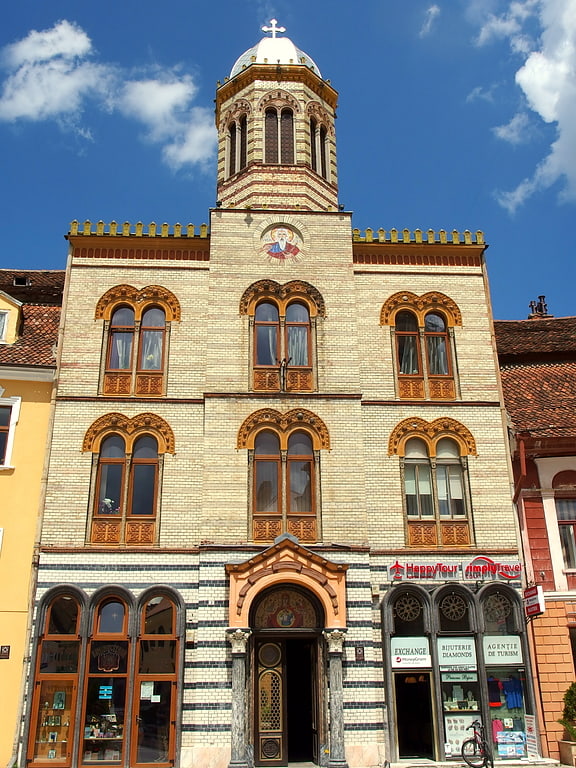
The Piața Sfatului Orthodox Church is a Romanian Orthodox church located at 3 Piața Sfatului, Brașov, Romania. It is dedicated to the Dormition of the Theotokos.
A small one-room chapel opened inside the Brașov Citadel in 1829. In 1866, due to deterioration, it was closed down, its congregants assigned to the Greek Church. In 1895, Archbishop Miron Romanul laid the cornerstone of the present church, which was dedicated by his successor Ioan Mețianu in 1899. The church represented a symbolic advance for the city’s Romanians, from the peripheral St. Nicholas into the main square, traditionally a Saxon space.
The style is neo-Byzantine, with a central dome and bell tower. It measures 26.6 by 12.3 meters. A spire facing Piața Sfatului was added later. This collapsed during the 1940 Vrancea earthquake and was rebuilt in 1973. The iconostasis is carved and gilt, and was painted in 1898. The interior painting, dating to 1937, was restored in 1965–1966, 1985 and 2005.
The church is listed as a historic monument by Romania's Ministry of Culture and Religious Affairs.[6]
Piața Sfatului
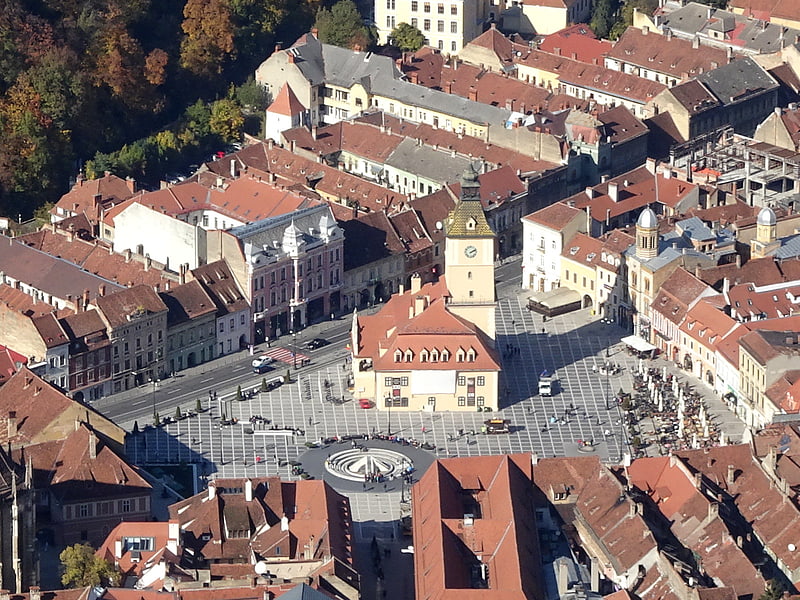
Council in Brașov, Romania. The Council Square is located in the historic centre of Brașov, Romania. It obtained its right to hold markets in 1520, but it has been the place for weekly and annual markets since 1364, being visited by merchants from the country and abroad. It is surrounded by 18th-19th century houses, most of which are historical monuments.
A pillory, in the middle of the square, was used as a means for public humiliation, punishment and scorn. Witches were also punished here, but the head of the shoemaker guild, Stefan Stenert, who opposed the entry of the Austrian army into Brașov, was also beheaded here in 1688. Until 1892, there were two wells in the square. The most important building in the square is the former Council House (Casa Sfatului), which was built in 1420 and is located in the middle of the square. This now houses the Brașov County Museum of History.
Around the main square is the picturesque pedestrian-only Republicii street, the Black Church, former Council House, indoor and outdoor terraces and restaurants, the Orthodox Church, Casa Mureșenilor museum, Museum of Urban Civilization, and Hirscher House.
A local tradition holds that the children that the Pied Piper of Hamelin (Germany) sent underground appeared near this Brașov square.
In the communist era, the Council Square was named "Piața 23 August" (23 August Square).[7]
Address: Piata Sfatului, Brașov
Brașovia Citadel

Brașovia Fortress was a fortification located on the saddle of Tâmpa mountain at Brașov, Romania. John Hunyadi had it demolished by the beginning of 1455.[8]
First Romanian School
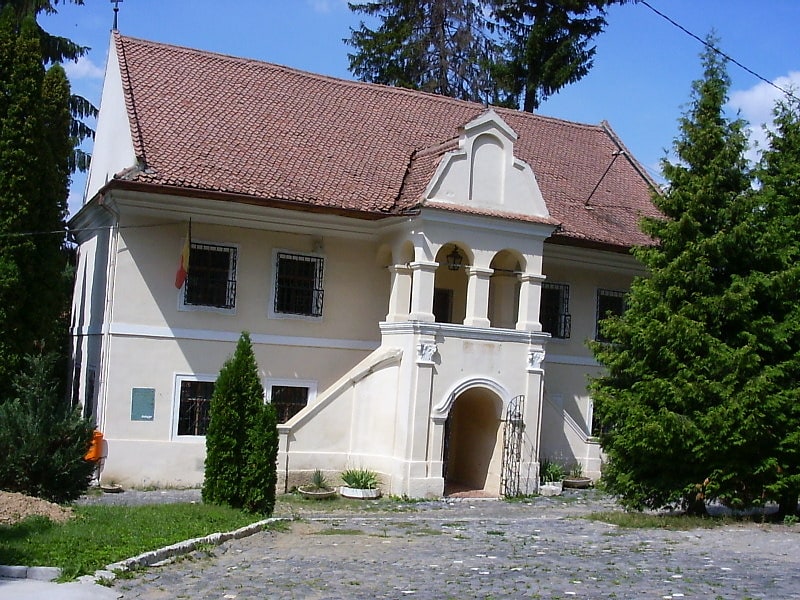
Also known as: Prima școală românească
School in Brașov, Romania. The First Romanian School is located on the grounds of the 16th-century St. Nicholas Church, itself located in the historic district of Șcheii Brașovului, in what is now Brașov, Romania. This is the first school on the territory of present-day Romania where Romanian language was used in teaching.[9]
Address: Piata Unirii 2-3, 500123 Brasov
Black Tower
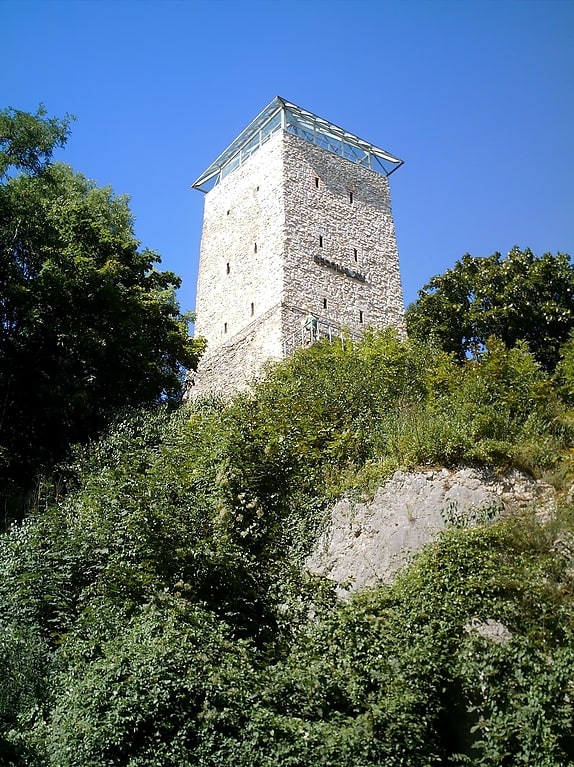
Also known as: Turnul Negru din Brașov
Monument in Brașov, Romania. Black Tower is a fort of Braşov, Romania
The tower located on a large rock on Warthe Hill. The purpose of the tower was to deny enemy soldiers access to the city walls, which, in this case, were no further than 5 meters (the pass was only widened in 1819–1820).[10]
Address: Str. După Ziduri, 500026 Brașov
Tocile Church
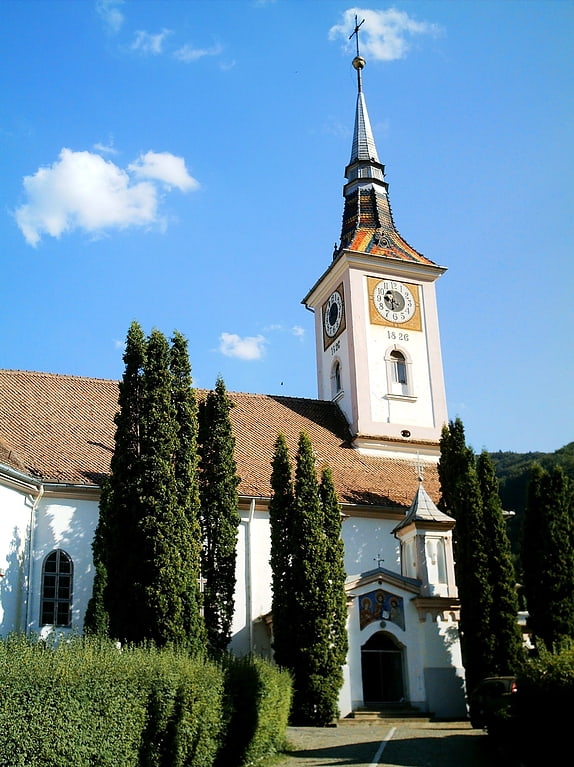
The Tocile Church is a Romanian Orthodox church located at 57 Vasile Saftu Street, Brașov, Romania. Located in the Tocile section of Șcheii Brașovului, it is dedicated to the Holy Trinity.
In the late 18th century, there were over 1000 Orthodox families in Șchei, all assigned to St. Nicholas Church. After numerous petitions, the residents of the Tocile area were permitted to build a chchurch in 1812. Construction began in 1824, with the ktetor list being headed by Grigore IV Ghica, Prince of Wallachia. Completed the following year, the church was consecrated in 1831 by Bishop Vasile Moga. In 1855, when the parish numbered 1395 members, repairs were done on the roof, facade and cemetery walls, to which gates were added in 1860.
The church is in Gothic Revival style, its central nave of stone and brick measuring 35 by 11.5 meters at the apses and 32 meters high. The clock on the spire dates to 1857 and cost 600 forints, donated by two Bucharest families. The church was painted during the same year: Constantin Lecca did the altar murals, while Mișu Popp is attributed part of the iconostasis and the rest of the church. Only a small area above the north door was painted later. The ensemble was restored in 2001–2003.
The nearby graveyard features old crosses and the resting places of prominent locals. Andrei Mureșanu lay there until 1883, when his remains were moved to the more central Groaveri Cemetery. The church is listed as a historic monument by Romania's Ministry of Culture and Religious Affairs, as are the 1781 parish house and the cemetery.[11]
St. Nicholas Church
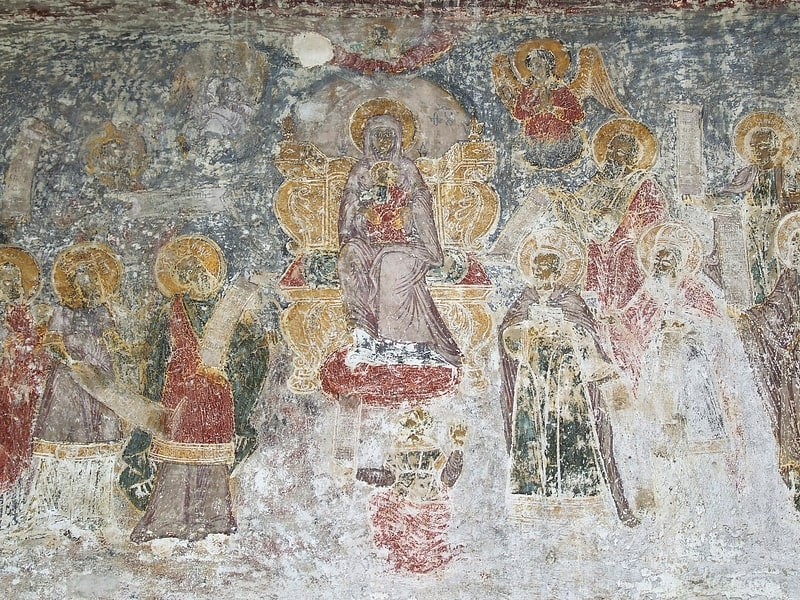
Also known as: Biserica Sfântul Nicolae din Brașov
Historic Orthodox church with frescoes. Saint Nicholas Church is a Romanian Orthodox church in Brașov, dominating the historic district of Șcheii Brașovului.[12]
Address: Piața Unirii 1, 500123 Brașov
Dârste Church
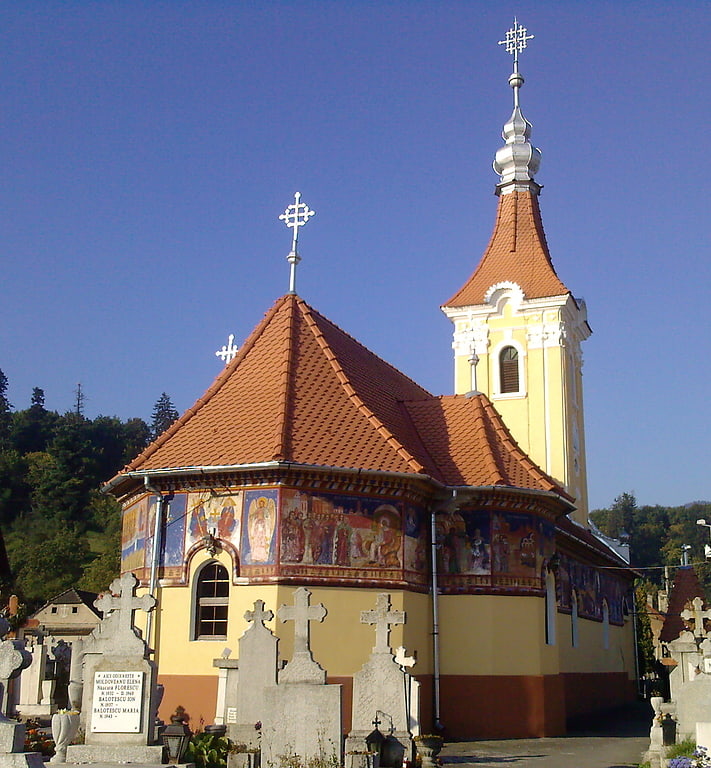
The Dârste Church is a Romanian Orthodox church located at 255 Calea București, Brașov, Romania. Located in Dârste, a former village that is now a district of Brașov, it is dedicated to the Holy Trinity.
Before the church was built, the local Orthodox community worshiped in Săcele and Brașov. In 1783, during a visit by Joseph II, the villagers handed him a petition requesting permission to establish a church. This was soon granted, and the first ktetor purchased a plot of land. Later, in 1796, Bishop Gerasim Adamović consecrated the church.
The architectural style resembles that of other Orthodox churches in the Burzenland. In terms of shape, height and exterior decor, it recalls four historic churches of Săcele. Several icons date to 1784, while the wall frescoes are from 1833. The earliest surviving fresco is in the altar, and shows Jesus lying in the tomb. The painting was restored in the 1970s and again in the 1990s.
The church is listed as a historic monument by Romania's Ministry of Culture and Religious Affairs, which supplies a completion date of 1783.[13]
Brașovechi Church
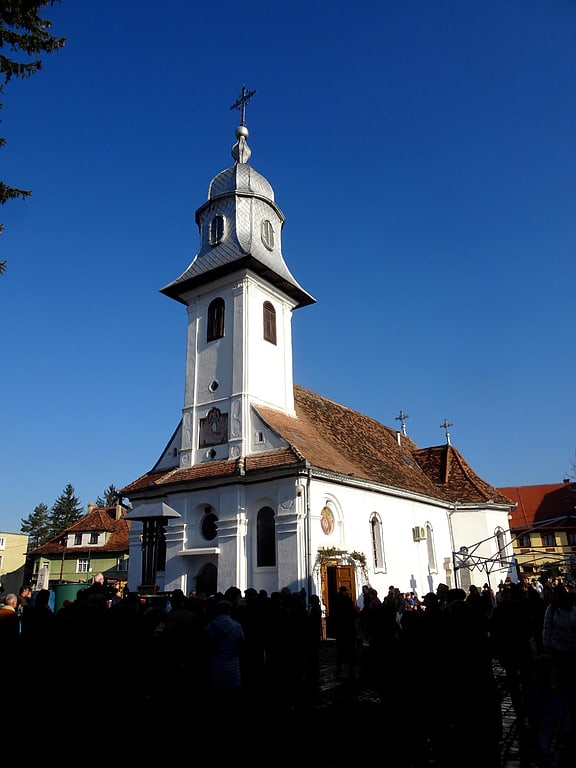
The Brașovechi Church, also known as "The Dormition of the Mother of God" Church " is a Romanian Orthodox church located at 47 Bisericii Române Street, Brașov, Romania. Located in the Brașovechi district, it is dedicated to the Dormition of the Theotokos.
After the Patent of Toleration was issued in 1782, the Romanians of Brașov sent a number of petitions to the local and Viennese authorities, asking to build a church. Ștefan Nicola, a wealthy merchant of Șcheii Brașovului and a Greek originally from Ioannina, promised a magistrate that he would pay the entire cost. As a result, a decree of October 1782 approved a “chapel” and adjacent cemetery near a barracks. The church was built in 1783, and its street was named after the church the same year. The parish served the Romanian population living below the city walls.
Made of brick and stone, the church is built in a late Baroque style, in a three-lobed shape. There is an altar apse and two side apses; these are polygonal on the exterior and semicircular on the interior. The square western tower sits atop the vestibule, holding the bells. It was initially covered in tiles, replaced by brass plates in 1928. The tile roof is saddle-shaped. Dedicated in 1785 by Bishop Gideon Nikitić, the church maintains its original aspect.
The church was painted in fresco from 1783 to 1790 by four brothers from Săsăuș; they had established an iconographers’ school in Săcele in 1780. Over time, the work deteriorated, so that by the time the church was repainted in 1946–1949, only small fragments survived. The wooden iconostasis was partly destroyed by fire in 1977, and repaired by 1981. Ioan Bran de Lemény is buried in the graveyard.
The church is listed as a historic monument by Romania's Ministry of Culture and Religious Affairs.[14]
Address: 47 Strada Bisericii Române, Brașov
Șchei Gate
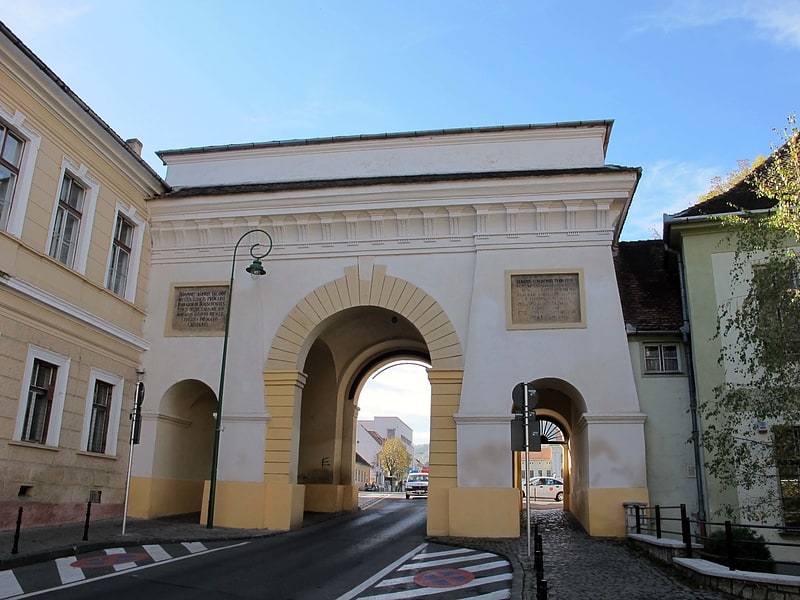
Also known as: Poarta Șchei din Brașov
Historical gate with 3 archways. Șchei Gate in the Șcheii Brașovului neighborhood of Brașov, Romania, is right next to Catherine's Gate. It was built in between 1827 and 1828 in order to let through heightened traffic. The much bigger Catherine's Gate was demolished at the same time, with the exception of the tower of the exterior gate, which was used as storage.
The stone and brick gate, built in classical style like a triumphal arch, has three openings. The middle arch, shaped for traffic, is larger, and on its both sides there are two smaller and lower openings for pedestrians. The Latin inscriptions on the wall above the small arches let us know the construction date, but they also inform us that the gate was built after the Emperor of Austria, Francis I, visited Brașov in 1817.[15]
Address: Str. Poarta Schei, 500020 Brașov